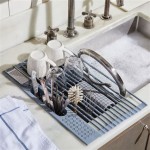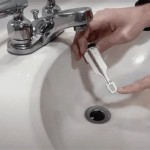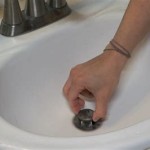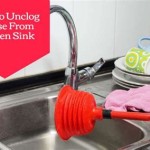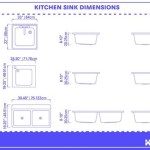How to Clean Rust from a Stainless Steel Sink
Stainless steel sinks are a popular choice for kitchens due to their durability and resistance to many common household stains. However, even stainless steel is not entirely immune to rust. What appears as rust on a stainless steel sink is often not the corrosion of the steel itself, but rather rust particles deposited onto the surface from external sources. These sources can include iron cookware, rusty pipes, or even hard water with a high iron content. The deposited rust can then create unsightly stains and, if left untreated, could potentially contribute to more significant problems over time. Effectively removing this rust and restoring the sink's shine requires understanding the nature of the issue and employing appropriate cleaning techniques.
The key to successful rust removal lies in choosing the right cleaning agents and methods. Abrasive cleaners and harsh chemicals can scratch and damage the stainless steel surface, making it more susceptible to future rust accumulation. Therefore, a gentle approach, starting with mild cleaning solutions and gradually progressing to more potent options if necessary, is recommended. This article will provide a comprehensive guide on how to effectively clean rust from a stainless steel sink, outlining several methods, safety precautions, and preventative measures.
Identifying the Source of the Rust
Before embarking on the cleaning process, it is important to identify the potential source of the rust. Understanding the root cause can help prevent its recurrence and ensure the sink remains clean and rust-free for longer. As mentioned previously, the rust on a stainless steel sink is usually not corrosion of the stainless steel itself. Stainless steel contains chromium, which reacts with oxygen to form a thin, invisible layer of chromium oxide that protects the underlying steel from corrosion. However, this protective layer can be compromised by harsh chemicals, scratches, or prolonged exposure to corrosive substances.
Common sources of rust deposits on stainless steel sinks include:
*Iron Cookware:
Placing cast iron or other iron-containing cookware in the sink, especially when wet, can transfer rust particles to the stainless steel surface. *Rusty Plumbing:
Old or corroded pipes can release rust particles into the water supply, which can then settle on the sink. *Hard Water:
Water with a high iron content can leave rust stains as it evaporates. *Steel Wool or Abrasive Pads:
Using steel wool or highly abrasive cleaning pads can scratch the stainless steel and leave behind tiny iron particles that rust. *Rusting Objects:
Even seemingly innocuous metal objects left in the sink, like paper clips or tin cans, can rust and stain the surrounding stainless steel. *Fertilizers
: Fertilizers left on the surface can result in iron accumulating on the surface which can stain the stainless steel.Once the potential source of the rust is identified, steps can be taken to mitigate it. For example, using a water softener can address hard water issues, and avoiding the use of steel wool can prevent further scratching and iron particle deposition.
Cleaning Methods for Rust Removal
There are several methods for removing rust from a stainless steel sink, ranging from mild to more aggressive approaches. It is best to start with the gentlest method and only move on to stronger solutions if necessary. Always test any cleaning solution in an inconspicuous area of the sink first to ensure it does not cause discoloration or damage.
The following cleaning methods are commonly used for rust removal from stainless steel sinks:
*Baking Soda Paste:
Baking soda is a mild abrasive that can effectively lift rust stains without scratching the stainless steel. To use, mix baking soda with a small amount of water to form a thick paste. Apply the paste to the rust stains and let it sit for 15-20 minutes. Then, scrub gently with a soft cloth or sponge and rinse thoroughly with water. *Vinegar:
Vinegar is a mild acid that can dissolve rust. White vinegar or apple cider vinegar can be used. Soak a cloth or sponge in vinegar and apply it to the rust stains. Allow the vinegar to sit for 30 minutes to an hour. Then, scrub gently with a soft cloth or sponge and rinse thoroughly with water. For stubborn stains, you can try diluting the vinegar with water and soaking a paper towel in the solution, then placing the paper towel over the affected area for a longer period. *Lemon Juice and Salt:
The acidity of lemon juice combined with the mild abrasiveness of salt can create an effective rust-removing solution. Cut a lemon in half and sprinkle salt on the cut surface. Use the lemon to scrub the rust stains, applying gentle pressure. Rinse thoroughly with water. *Cream of Tartar:
Cream of tartar is a mild abrasive that can be used to remove rust stains. Mix cream of tartar with a small amount of water to form a paste. Apply the paste to the rust stains and let it sit for 10-15 minutes. Then, scrub gently with a soft cloth or sponge and rinse thoroughly with water. *Oxalic Acid-Based Cleaners:
Oxalic acid is a more powerful rust remover that is found in some commercial cleaning products. These products should be used with caution, following the manufacturer's instructions carefully. Always wear gloves and eye protection when using oxalic acid-based cleaners, and ensure the area is well-ventilated. *Bar Keeper's Friend:
Bar Keeper's Friend is a popular cleaning powder that contains oxalic acid, but in a lower concentration than dedicated oxalic acid cleaners. It is generally considered safe for use on stainless steel, but it is still important to test it in an inconspicuous area first. Apply a small amount of the powder to a wet sponge or cloth and scrub the rust stains gently. Rinse thoroughly with water. *Specialized Stainless Steel Cleaners:
There are numerous stainless steel cleaners available on the market that are specifically formulated to remove rust and other stains. These cleaners often contain a combination of cleaning agents and polishing compounds that can restore the sink's shine. Follow the manufacturer's instructions carefully when using these products.When scrubbing, always use a soft cloth or sponge to avoid scratching the stainless steel. Scrub in the direction of the grain of the stainless steel to minimize the appearance of any scratches. After cleaning, rinse the sink thoroughly with water and dry it with a clean cloth to prevent water spots.
Preventative Measures to Avoid Rust Accumulation
Preventing rust accumulation is always preferable to having to remove it. Implementing a few simple preventative measures can significantly reduce the likelihood of rust stains appearing on your stainless steel sink. These measures include:
*Rinsing the Sink Regularly:
Regularly rinsing the sink with water, especially after washing dishes or using iron cookware, can help prevent rust particles from settling on the surface. *Drying the Sink After Use:
Drying the sink with a clean cloth after each use can prevent water spots and rust stains from forming. *Avoiding Steel Wool and Abrasive Cleaning Pads:
As mentioned previously, steel wool and abrasive cleaning pads can scratch the stainless steel and leave behind iron particles that rust. Use soft cloths, sponges, or non-abrasive cleaning pads instead. *Protecting the Sink from Iron Cookware:
Avoid placing iron cookware directly in the sink, especially when wet. Use a sink protector or mat to create a barrier between the cookware and the stainless steel surface. *Addressing Hard Water Issues:
If you have hard water, consider installing a water softener to reduce the iron content in the water. *Maintaining Plumbing:
Regularly inspect and maintain your plumbing system to prevent rust from entering the water supply. *Using Stainless Steel-Specific Cleaners:
Regularly cleaning the sink with a stainless steel-specific cleaner can help protect the surface and prevent rust accumulation. *Applying a Stainless Steel Polish:
Applying a stainless steel polish can help create a protective layer on the surface, making it more resistant to rust and other stains. *Proper Ventilation
: Humidity can result in rust appearing more quick than normal. Ensure that the kitchen ventilation is operating properly and that the room is receiving fresh air on a regular schedule.By following these preventative measures, you can significantly reduce the risk of rust accumulation and keep your stainless steel sink looking its best.
In addition to the above, it's also important to be mindful of the types of soaps and detergents used in the sink. Some harsh chemicals found in certain cleaning products can damage the protective layer of stainless steel, making it more susceptible to rust. Opt for mild, pH-neutral soaps and detergents specifically designed for stainless steel surfaces.
Furthermore, avoid leaving wet sponges or cloths in the sink for extended periods. These can trap moisture and create a breeding ground for bacteria and mold, which can contribute to staining and corrosion. Always wring out sponges and cloths thoroughly and store them in a well-ventilated area.

Rust In Your Stainless Steel Sink Duncan S Creative Kitchens

How To Remove Rust From A Stainless Steel Sink Clean Polish And Re Bar Keepers Friend

7 Diy Remedies For Removing Rust From Stainless Steel Homedit

How To Remove Rust From Stainless Steel Sinks Ruvati Usa

How To Clean A Stainless Steel Sink And Your Drain Too

How To Remove Rust From A Stainless Steel Sink Clean Polish And Re Bar Keepers Friend Youtube
How To Clean Rust Stains Off Of A Stainless Steel Sink Living On Dime

How To Clean A Stainless Steel Sink And Make It Shine Simple 3 Step Solution With Ingredients Found Around Your Home The Thrifty Couple

Clean A Stainless Steel Sink Easily With Wd 40 Australia

How To Remove Rust From Stainless Steel Effective Cleaning Tips
